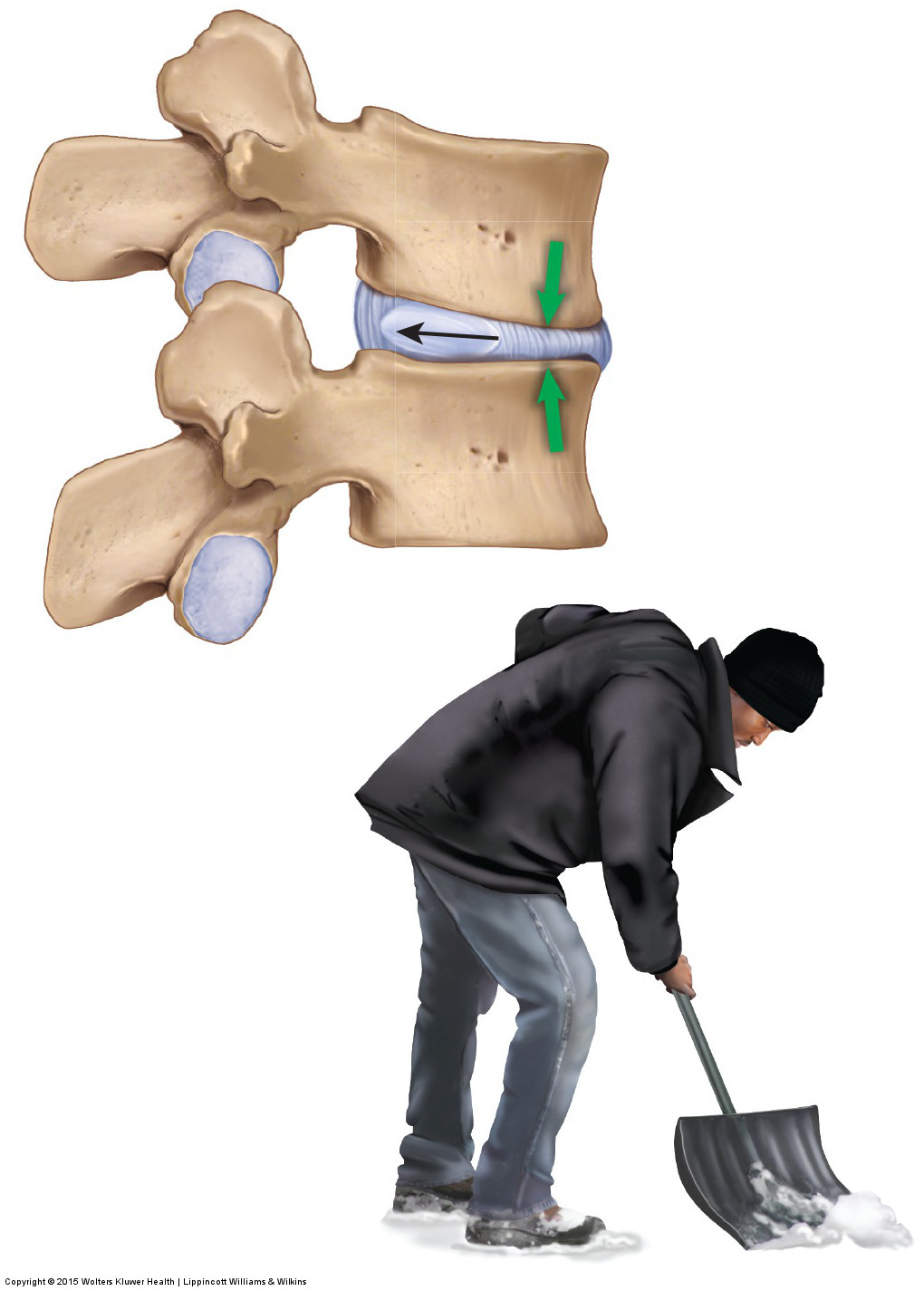Causes:
There are three types of pathologic disc:
- degenerated disc
- bulging disc
- herniated disc (aka ruptured or prolapsed disc)
A degenerated disc (pathologic disc) is caused by wear and tear, in other words the accumulation of physical stress forces placed upon it. These physical stressors can be repeated microtraumas of posture and movement, or larger macrotraumas due to physical injuries such as falls or car accidents. Therefore, the condition of degenerated disc tends to progress with aging. Although all physical forces through the discs can contribute to degenerative disc disease, the principal physical stressors for the cervical and lumbar regions differ.

Flexion drives the nucleus pulposus posteriorly against the annulus fibrosus of the disc. Permission: Joseph E. Muscolino. Manual Therapy for the Low Back and Pelvis – A Clinical Orthopedic Approach (2015).
The discs of the lumbar spine are greatly affected by weight bearing compression force. Therefore, prolonged standing or sitting postures are unhealthy. The effects of weight bearing are increased if the client/patient is overweight. Lumbar discs are also stressed by shock forces from striking the ground below (ground reaction forces); for example walking and running on hard surfaces such as asphalt or concrete. Weight bearing and pounding also affect cervical discs, but the principal stressors for cervical discs are unhealthy postures and movement patterns of the neck and arm, and whiplash injuries.
The process of pathologic disc degeneration in both the cervical and lumbar regions can be accelerated by tight musculature. If vertically oriented paraspinal musculature becomes tight, there is a pulling force on the superior and inferior attachments toward the center of the musculature, causing compression of the vertebrae that are located between.
A bulging or herniated pathologic disc may develop as a result of the accumulation of the same physical stressors that lead to disc degeneration. Another physical stressor that is especially contributory to bulging and herniated discs is the posture of spinal flexion. Spinal flexion compresses the anterior aspect of the discs. This stretches taut the posterior annular fibers at the same time that it drives the nucleus pulposus posteriorly against the taut posterior fibers. The combination of pulling the posterior annulus taut as the nucleus is driven against it causes fraying of the fibers. This leads to weakness or rupture of the posterior annular wall. These bulges and herniations tend to occur posterolaterally because the midline posterior annulus is reinforced by the posterior longitudinal ligament.
If the aforementioned physical stressors do not actually cause a pathologic disc (bulging or herniated), then they certainly weaken the posterior annulus, predisposing it to a bulge or herniation if a macrotrauma then occurs. In other words, the macrotrauma is often the straw that breaks the proverbial camel’s back. A common macrotrauma for the cervical discs is a whiplash accident in which the neck is forcibly thrown into flexion and extension.
For the lumbar spine, a common macrotrauma that leads to a pathologic disc (bulging or herniated) occurs when the client/patient bends over to pick up an object. Irrespective of the weight of the object being picked up, when the client/patient bends forward, the entire weight of the client’s trunk must be supported by the paraspinal (erector spinae and transversospinalis) extensor musculature of the trunk. The contraction of the paraspinal musculature acts to stabilize the spine, but it also causes disc compression. As the client/patient leans progressively forward, the paraspinal musculature is increasingly stretched and loses effective strength (because of the length tension relationship curve of musculature in which fewer myosin actin cross-bridges are formed when a muscle lengthens). Therefore, the musculature is less able to stabilize and support the spine and more of the stress falls on passive tissues, including the fibers of the disc. And, due to the position of flexion, the posterior annular fibers are under great tensile force as they are stretched and the nucleus is being driven against them. If the client/patient happens to twist/rotate their trunk as they bend, the risk of a disc bulge or herniation is further increased because rotating in either direction (right or left), slackens half of the annular fibers, causing the other half of the fibers to bear the entire stress of this posture. Failure of the posterior annular fibers often occurs, resulting in bulging or herniation of the disc. If the object being picked up is heavy, it further increases the chance of injury because it adds to the weight bearing upon the lumbar spine.


